Salvete history-lovers!
We’re at the half-way point in this blog series about The World of The Blood Road. I hope you’ve enjoyed it thus far. A lot of research goes into every Eagles and Dragons novel, and I’m thrilled to share it with you!
If you missed Part IV on the Praetorian Guard and the Castra Praetoria at Rome, you can read that post by CLICKING HERE.
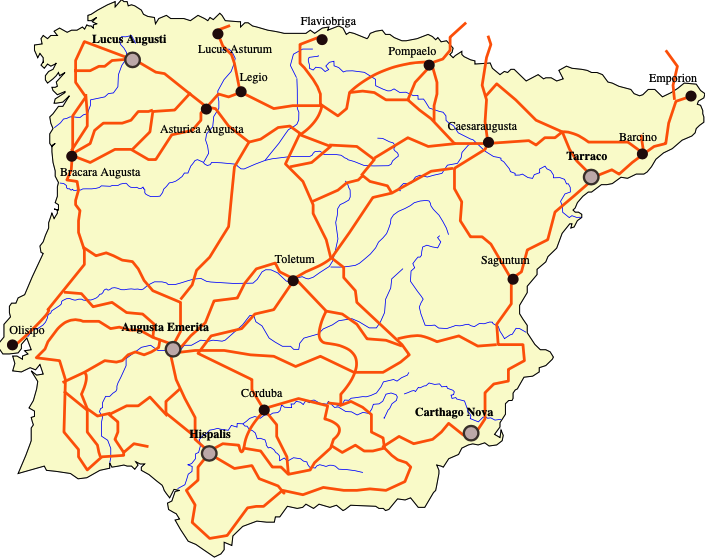
Roman Spain, with Carthago Nova at the bottom right, on the Mediterranean coast
In Part V of this blog series we’re going to be taking a look at one of the locations visited by the main characters: the Iberian city of Carthago Nova, or, ‘New Carthage’.
One of the joys of writing historical fiction in the Roman Empire is that you have myriad options for setting open to you. The Roman world was vast and varied. It never gets boring. Like the people inhabiting it, the terrain and settlements are all different. The Roman Empire is perhaps the most diverse, multi-cultural civilization in ancient human history.
Carthago Nova, modern Cartagena in southern Spain, is no exception, and its history and development are fascinating. In this post, we’re going to take a very brief look at this ancient settlement.
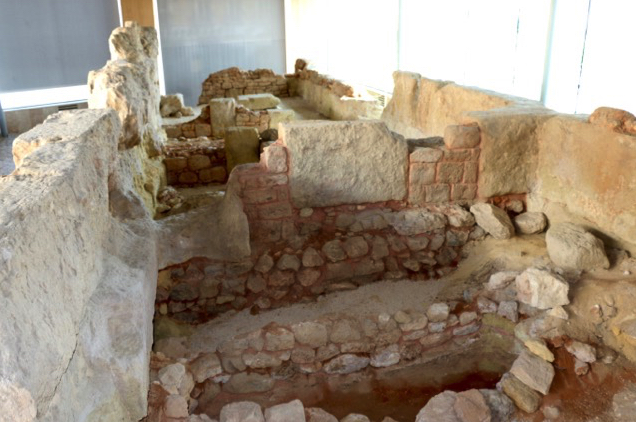
Remains of Punic walls of Qart Hadasht
It [Carthago Nova] stands about half-way down the coast of Iberia in a gulf which faces south-west, running about twenty stades inland, and about ten stades broad at its entrance. The whole gulf is made a harbour by the fact that an island lies at its mouth and thus makes the entrance channels on each side of it exceedingly narrow. It breaks the force of the waves also, and the whole gulf has thus smooth water, except when south-west winds setting down the two channels raise a surf: with all other winds it is perfectly calm, from being so nearly landlocked. In the recess of the gulf a mountain juts out in the form of a chersonese, and it is on this mountain that the city stands, surrounded by the sea on the east and south, and on the west by a lagoon extending so far northward that the remaining space to the sea on the other side, to connect it with the continent, is not more than two stades. The city itself has a deep depression in its centre, presenting on its south side a level approach from the sea; while the rest of it is hemmed in by hills, two of them mountainous and rough, three others much lower, but rocky and difficult of ascent; the largest of which lies on the east of the town running out into the sea, on which stands a temple of Asclepius. Exactly opposite this lies the western mountain in a closely-corresponding position, on which a palace had been erected at great cost, which it is said was built by Hasdrubal when he was aiming at establishing royal power. The remaining three lesser elevations bound it on the north, of which the westernmost is called the hill of Hephaestus, the next to it that of Aletes,—who is believed to have attained divine honours from having been the discoverer of the silver mines,—and the third is called the hill of Cronus. The lagoon has been connected with the adjoining sea artificially for the sake of the maritime folk; and over the channel thus cut between it and the sea a bridge has been built, for beasts of burden and carts to bring in provisions from the country.
(Polybius, Histories, 10.10)
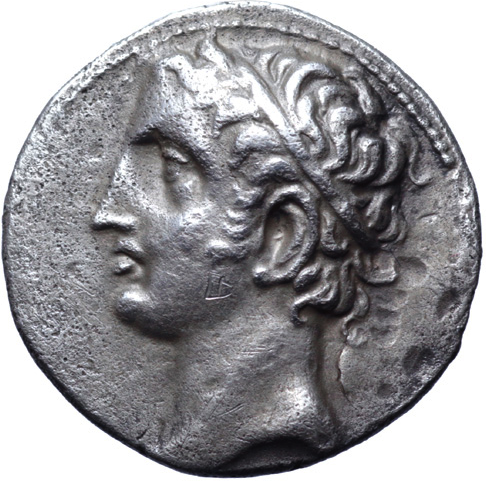
Coin showing image of Hasdrubal the Fair
Originally, Carthago Nova, which is its later Roman name, may have been a Phoenician trading centre named ‘Mastia’. However, the settlement really took off and began to flourish under Carthage as Qart Hadasht (meaning ‘New City’) which was founded by the Carthaginian general Hasdrubal the Fair, the son-in-law of Hamilcar Barca, in 228 B.C.
After Carthage took the Iberian peninsula, Qart Hadasht became the seat of Punic power there. It thrived as a trade centre, but also as a supply station and base of operations from which, during the Second Punic War, Hannibal would strike out for northern Italy.
Qart Hadasht thrived because of trade, the excellent port, and the nearby silver mines. But success was a double-edged gladius. All the success the city enjoyed angered other trading centres, especially Massilia, an allied Roman city.
And Massilia complained to Rome.
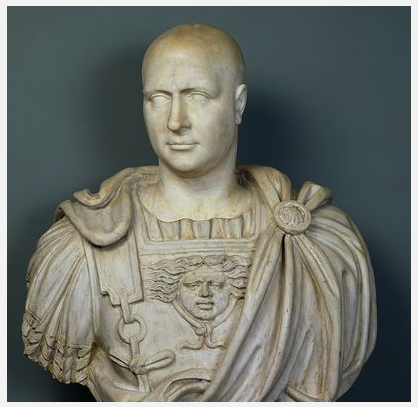
Bust of Scipio Africanus
By the time the second Punic war came about, Rome was taking a closer look at the problem of Qart Hadasht. Actually, it was one Roman in particular: Publius Cornelius Scipio.
He [Scipio] therefore rejected that idea altogether: but being informed that New Carthage was the most important source of supplies to the enemy and of damage to the Romans in the present war, he had taken the trouble to make minute inquiries about it during the winter from those who were well informed. He learnt that it was nearly the only town in Iberia which possessed a harbour suitable for a fleet and naval force; that it lay very conveniently for the Carthaginians to make the sea passage from Libya; that they in fact had the bulk of their money and war material in it, as well as their hostages from the whole of Iberia; that, most important of all, the number of fighting men garrisoning the citadel only amounted to a thousand,—because no one would ever suppose that, while the Carthaginians commanded nearly the whole of Iberia, any one would conceive the idea of assaulting this town; that the other inhabitants were exceedingly numerous, but all consisted of craftsmen, mechanics, and fisher-folk, as far as possible removed from any knowledge of warfare. All this he regarded as being fatal to the town, in case of the sudden appearance of an enemy. Nor did he moreover fail to acquaint himself with the topography of New Carthage, or the nature of its defences, or the lie of the lagoon: but by means of certain fishermen who had worked there he had ascertained that the lagoon was quite shallow and fordable at most points; and that, generally speaking, the water ebbed every day towards evening sufficiently to secure this. These considerations convinced him that, if he could accomplish his purpose, he would not only damage his opponents, but gain a considerable advantage for himself; and that, if on the other hand he failed in effecting it, he would yet be able to secure the safety of his men owing to his command of the sea, provided he had once made his camp secure,—and this was easy, because of the wide dispersion of the enemy’s forces. He had therefore, during his residence in winter quarters, devoted himself to preparing for this operation to the exclusion of every other: and in spite of the magnitude of the idea which he had conceived, and in spite of his youth…
(Polybius, Histories, 10.8)
As we know, Scipio (later known as ‘Africanus’ after his victory over Hannibal), was a smart general. He did his research before attacking Qart Hadasht while Hannibal was attacking Italy.
As a result, the Iberian city was taken by Scipio in 209 B.C. and became known as ‘Cathago Nova’, which literally means ‘New New City’.
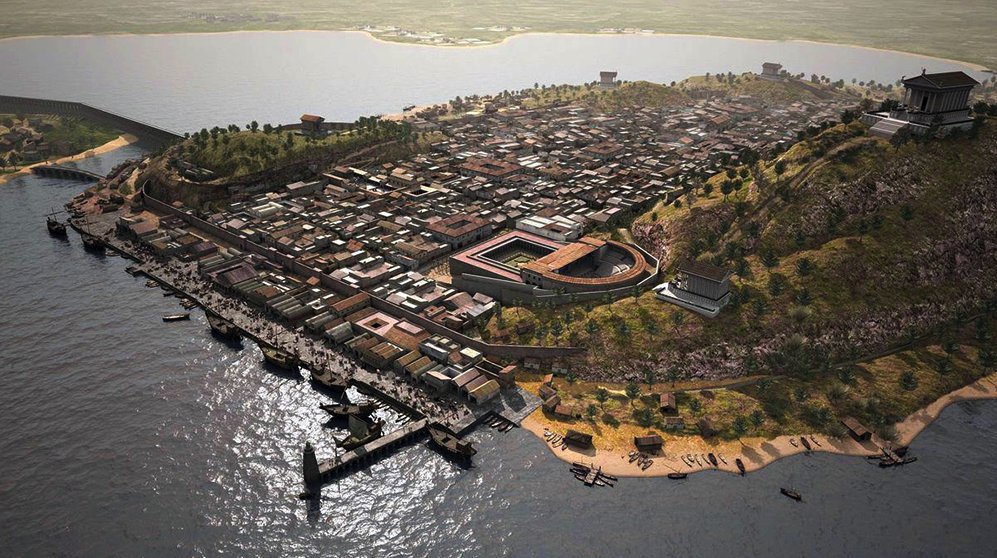
Digital reconstruction of Roman Carthago Nova
Carthago Nova, or ‘Colonia Urbs Julia Nova Carthago’, played an important role in Rome’s economy over the years. It was one of Rome’s major centres of trade and one of the main suppliers of the silver which was so important to pay Rome’s legions.
From Carthago Nova, Iberian goods were shipped to Italy and all over the Empire, including silver, salt, fish for garum, grain, and esparto grass which was used for rope making and basket weaving.
Under Roman rule, it was a safe city, and was the third major city in Iberia after Tarraco and Corduba.
In 44 B.C. it was made a colonia by Julius Caesar in recompense for the city’s help in his civil war against Pompey and, as a result, all free-born men of Carthago Nova were made Roman citizens.
Augustus showed further favour to the city by giving it new streets, a theatre, a proper forum, various monuments, an ‘Augusteum’, temples and a college.
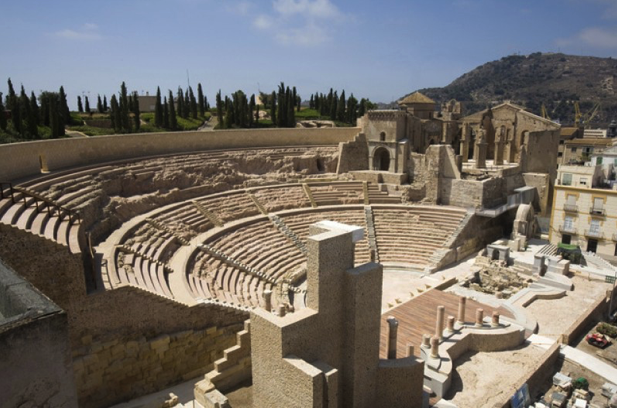
Remains of the Roman theatre of Carthago Nova (today’s Cartagena)
By the mid-third century, after the period in which The Blood Road takes place, Carthago Nova fell on hard times with the disruption of the silver mining operations, and the abandonment of the eastern part of the city.
Emperor Diocletian tried to help the city by making it the capital of his newly-created province of Hispania Cathaginensis in around A.D. 298, but the respite only lasted for a short time.
In A.D. 409, the Vandals took the city, and it subsequently fell into the hands of the Visigoths in A.D. 425. From then on, it seemed Carthago Nova was destined to be ruled through a revolving door with power passing to the Byzantines, the Moors, and then into Christian hands during the Spanish Reconquista of the late Middle Ages.
This is the fascinating thing about ancient cities; no matter which one you choose to look at, you will find a long, rich history, marked by ups and downs. The fortunes of these cities ebbed and flowed like the sea itself, but more often than not, when you research them, you will find that Rome was there.
I hope that you’ve enjoyed this brief post on the history of Carthago Nova.
Stay tuned for Part VI of The World of The Blood Road when we will take a look at one of my favourite places in the world: Etruria.
Thank you for reading.
The Blood Road is available on-line now in e-book and paperback at major retailers. CLICK HERE to get your copy. You can also purchase directly from Eagles and Dragons Publishing HERE.
If you are new to the Eagles and Dragons historical fantasy series, you can check out the #1 best selling prequel, A Dragon among the Eagles for just 1.99 HERE.



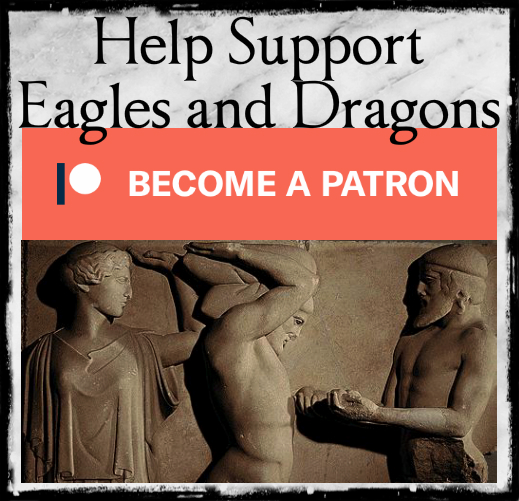
Hello Adam, your book “the Blood Road” arrived just yesterday which I have been waiting patiently for and I can’t wait to get on with reading it. I know once I begin I won’t want to put it down.Once I have finished reading it I will most certainly write a review. Hope all is well with you during these trying times and let’s hope we are nearing the end of having to cope with Covid . In the meantime you and your family stay safe.
Hi Rita! So glad your copy arrived safely stin Hellada! Hope you enjoy the new book 🙂 cheers and stay safe!